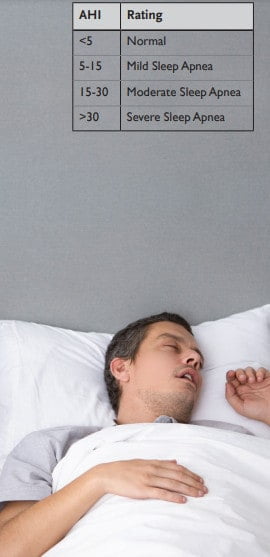Dr. Barry Glassman notes that diagnosing the role of OSA’s effect on our unique patient’s health is more complex than just looking at the patient’s AHI.
by Barry Glassman, DMD, and Don Malizia, DDS
Dentistry has an affinity for “cookbook” decision making regarding diagnosis and treatment. Finding a radiolucent area at the apex of a bicuspid that is causing pain makes diagnosis straightforward and recommended treatment predictable. Diagnosis and treatment become more complex and confounding when that tooth in pain does not demonstrate clear endodontic pathology.
Dentistry isn’t alone in its desire for a clear recipe for decision making. Medicine needed guidelines for blood sugar levels in diagnostic and treatment decision making protocols for diabetes. With a long history providing significant relevant data, it was determined that normal blood sugar levels after fasting should be less than 100 mg/dL. But it is known that normal blood levels vary, and that patients may have pre-meal blood levels that range anywhere from 60 to 90 mg/dL. The normal levels that vary for each patient have an effect on what level for each of those patients is indeed pathological. What A1C levels are required for atherosclerotic changes or altered pancreatic function to be noted? It is clear that each patient’s adaptive capacity is indeed different, and that numbers obtained from a blood sample at one given time alone can’t be used as a single definitive factor in treatment decision making.
There is a similar hunger for a cookbook approach in sleep medicine. Sleep medicine needed factors to help determine whether a patient actually had Obstructive Sleep Apnea (OSA) and whether or not that diagnosed OSA should be treated. The expediency of this decision was then accelerated by insurance companies that were suddenly bombarded with a “new disorder” that required standards to determine what levels would qualify for payment.
Sleep medicine is a relatively young field, and from its inception there was a realization that norms would be required to help guide therapy. What would sleep medicine use to determine severity of the disease the way that mg/dL are used in determining levels of diabetes? Despite the fact that it was developed as a validated tool to quantify the hypersomnolence of narcolepsy, the Epworth Sleepiness Scale (ESS) became the “standard” to evaluate the hypersomnolence often associated with OSA.1 Insurance companies set a minimum standard that was required for treatment even though patients can be at severe risk for fatal cardiovascular accidents, for example, without being hypersomnolent. The ESS became the most commonly used screening tool despite the fact that it has been shown that there is poor relationship between the ESS and the likelihood of having OSA and its severity.2
This cavalier approach to establishing norms leads our profession to consider the glaring shortcomings of using Apnea Hypopnea Index (AHI) alone as a major factor in determining severity of disease. Therefore, its current use in guiding treatment is problematic. Several authors have recently questioned the use of AHI in this manner.
In a recent personal communication, Dr. Larry Lockerman spoke of approaching Dr. Christian Guilleminault, a well-known researcher who was one of the early pioneers in sleep medicine and is credited with coining the term “obstructive sleep apnea.” Following a conference presentation, Dr. Lockerman asked Dr. Guilleminault how AHI became the determining factor in the diagnosis of OSA and how the number “5” was reached as the acceptable “norm?” Dr. Guilleminault told him that early in the development the insurance companies needed to know when a patient should be treated, so he “made up” the number 5 as the “norm” and the number 15 as that number which required treatment. Dr. Guilleminault admitted that he was “sorry” he did that.3
AHI is a measure of the number of respiratory episodes per hour during sleep. There are many variables the AHI does not consider that have resulted in peer reviewed literature demonstrating a lack of relationship between AHI and severity of the comorbidities associated with the disorder. The most obvious issue is the definition of a respiratory event itself. Medicare initially required an AHI of 20 for coverage. There was a point in time when Medicare played a major role in lowering the desaturation required to qualify as an event from 3% to 4%.
But of course, there are other variables that need to be considered, including length of events, the degree of oxygen desaturation with each event, and the endotype or phenotype of the patient altering the effect of the desaturation on the cardiovascular system and other potential comorbidities. Lavie points out the importance of the age of the patient in treatment decision making as well.4
It becomes obvious that diagnosing the role of OSA’s effect on our unique patient’s health and using that information intelligently to contribute to the risk benefit quotient when determining appropriate treatment options is more complex than simply looking at a single variable. It isn’t surprising that there is no direct dose related response relationship between AHI and disease.5
Medicine and dentistry’s desire to use this cookbook formula should not be surprising. As Ralph Waldo Emerson noted when discussing the tendency to attempt to make single markers more meaningful than they may in fact be:
“This reduction to a few laws, to one law, is not a choice of the individual, it is the tyrannical instinct of the mind.”6
An improved perspective on the role that AHI can play in our diagnosis and treatment planning should be celebrated – not feared and rejected. We need a more specific, realistic diagnosis with the presence of the disorder as well as the severity being recognized as the multivariable issue that it is. This will lead to improved diagnostically driven treatment planning more appropriate for the unique patient we are committed to helping. Elderly patients with no comorbidities and low level “pathological” AHIs should not be burdened with treatment that may not be required. No longer should patients titrated with oral appliance therapy and AHIs slightly over the normal level of “5” be advised that the appliance is “unsuccessful” and, despite being CPAP intolerant and in need of therapy, told to discontinue oral appliance use.
Once these additional markers are appropriately adopted, sleep medicine will no longer be inappropriately dependent on a single factor, and each patient will have their medical history, their age, their phenotype, and the details of their obstructive events considered in the treatment decision making.
Ralph Waldo Emerson would be proud.
Authors’ note: The following review is suggested reading as it provides an excellent summary of the history of the concept of AHI and the current literature and lack of supporting evidence and validation.
Pevernagie, D. A., B. Gnidovec-Strazisar, L. Grote, R. Heinzer, W. T. McNicholas, T. Penzel, W. Randerath, S. Schiza, J. Verbraecken and E. S. Arnardottir (2020). “On the rise and fall of the apnea−hypopnea index: A historical review and critical appraisal.” Journal of Sleep Research 29(4):
e13066.
Read more about AHI in “How To Read a Sleep Study Report,” here: https://dentalsleeppractice.com/sleep-study/read-sleep-study-report/
- Johns MW. Epworth Sleepiness Scale. 1991.
- Quan SF. Abuse of the epworth sleepiness scale. Journal of clinical sleep medicine : JCSM : official publication of the American Academy of Sleep Medicine 2013;9:987.
- Conversation with Dr. Larry Lockerman. 2021.
- Lavie P, Lavie L, Herer P. All-cause mortality in males with sleep apnoea syndrome: declining mortality rates with age. The European respiratory journal 2005;25:514-20.
- Pevernagie DA, Gnidovec-Strazisar B, Grote L et al. On the rise and fall of the apnea−hypopnea index: A historical review and critical appraisal. Journal of Sleep Research 2020;29:e13066.
- Emerson RW. Natural History of Intellect and other papers. Boston and New York: Houghton and Mifflin and Company, 1904.
 Barry Glassman, DMD, has earned Diplomate status with the American Board of Craniofacial Pain, the American Academy of Pain Management, and the American Board of Dental Sleep Medicine. He is also a Fellow of the International College of Craniomandibular Disorders. Among his recent publications are The Effect of Regional Anesthetic Sphenopalatine Ganglion Block on Self-Reported Pain in Patients with Status Migrainosus in Headache, and The Curious History of Occlusion in Dentistry in Dentaltown. He teaches and lectures internationally on orofacial pain, joint dysfunction, and sleep disorders.
Barry Glassman, DMD, has earned Diplomate status with the American Board of Craniofacial Pain, the American Academy of Pain Management, and the American Board of Dental Sleep Medicine. He is also a Fellow of the International College of Craniomandibular Disorders. Among his recent publications are The Effect of Regional Anesthetic Sphenopalatine Ganglion Block on Self-Reported Pain in Patients with Status Migrainosus in Headache, and The Curious History of Occlusion in Dentistry in Dentaltown. He teaches and lectures internationally on orofacial pain, joint dysfunction, and sleep disorders. Don Malizia, DDS, limits his practice to upper-quarter chronic pain and sleep disturbed breathing at the Allentown Pain & Sleep Center in Wilkes-Barre, Pennsylvania.
Don Malizia, DDS, limits his practice to upper-quarter chronic pain and sleep disturbed breathing at the Allentown Pain & Sleep Center in Wilkes-Barre, Pennsylvania.